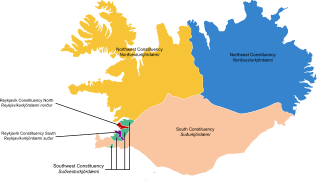Constituencies of Iceland
Iceland is divided into 6 constituencies for the purpose of selecting representatives to parliament.[1]

 |
|---|
| This article is part of a series on the politics and government of Iceland |
|
Government |
|
|
|
History
The current division was established by a 1999 constitution amendment and was an attempt to balance the weight of different districts of the country whereby voters in the rural districts have greater representation per head than voters in Reykjavík city and its suburbs.[1] The new division comprises three countryside constituencies (NW, NE and S) and three city constituencies (RN, RS and SW).[2] The imbalance of votes between city and country still exists and a provision in the election law states that if the number of votes per seat in parliament in one constituency goes below half of what it is in any other constituency, one seat shall be transferred between them.[1] This has occurred twice, in the elections in 2007 and 2013. On both occasions, a seat was transferred from the Northwest constituency to the Southwest constituency.[3]
Composition
The constituencies are the following:[2]
- Reykjavík Constituency North (Icelandic: Reykjavíkurkjördæmi norður)
- Reykjavík Constituency South (Icelandic: Reykjavíkurkjördæmi suður)
- Southwest Constituency (Icelandic: Suðvesturkjördæmi)
- Northwest Constituency (Icelandic: Norðvesturkjördæmi)
- Northeast Constituency (Icelandic: Norðausturkjördæmi)
- South Constituency (Icelandic: Suðurkjördæmi)
Data for the table below is current as of the 2017 election:
| Constituency | Electors | Seats | Electors per seat |
%[lower-alpha 1] |
|---|---|---|---|---|
| Reykjavík North | 46,073 | 11 | 4,188 | 78.3% |
| Reykjavík South | 45,584 | 11 | 4,144 | 77.5% |
| Southwest | 69,544 | 13 | 5,350 | 100.0% |
| Northwest | 21,521 | 8 | 2,690 | 50.3% |
| Northeast | 29,620 | 10 | 2,836 | 55.4% |
| South | 36,143 | 10 | 3,251 | 67.6% |
| Source: Statistics Iceland | ||||
Notes
- Electors per seat as percent of the highest number in any constituency.
- National Electoral Commission of Iceland 2013, p. 4
- National Electoral Commission of Iceland 2013, p. 5
- National Electoral Commission of Iceland 2013, p. 6
References
- "Apportionment of Seats to Althingi, the Icelandic Parliament" (PDF). National Electoral Commission of Iceland. 2013. Retrieved 1 August 2015.
See also
External links
![]()
- (in Icelandic) Article on Alþingi website
